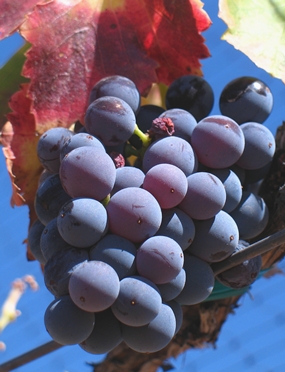Now listen; I don’t want to sound like a grumpy old git, but there’s one thing that really gets up my nose. Well, there are several things actually, but the others can wait. I find it irritating to see people clutching their wine glasses by the bowl, rather than by the stem. It’s as bad as holding a dinner knife like a pencil.
You see my dears, we should always hold our wine glass by the stem. One of the joys of wine-drinking is simply looking at the wine, for the appearance can tell you a lot – but not if your hand is around the bowl and the glass is smeared with greasy fingerprints. If you hold the bowl, your hand will heat the wine. Many wines are best when they’re chilled, so holding the stem will help preserve the temperature. When wine is too warm, the alcohol adds an unpleasant “bite” to the taste.
 Grenache grapes. (Photo by Josh McFadden)
Grenache grapes. (Photo by Josh McFadden)
“There is no occasion to hold a wineglass by the bowl,” says master sommelier Richard Betts. Michael Greenlee, a sommelier and restaurant director in New York City agrees. “You should always hold the glass by the stem,” he insists, “No matter what the shape or size of the glass, or the type of wine.” It is definitely un-chic to hold the bowl, as though you’re cradling a cup of coca.
At wine tastings, you sometimes see people holding the glass by the base, pinching it between the thumb and forefinger. I’ve often seen wine professionals holding their glasses in this curious way. But it’s impractical, because you have to use your other hand to put the glass down. In any case, it looks pretentious.
“Joy” Côtes du Rhône 2010 (red) France (Central and Tops, Bt. 499)
One of the big names in the Southern Rhône is Châteauneuf du Pape (“the New Castle of the Pope”). It’s a medieval hamlet, perched on the side of a hill just fifteen minutes up the road from Avignon, of “Sur Le Pont” fame. Give this ruby-red wine a sniff and you’ll get cherries, peppery spices and a kind of leathery earthiness which comes from the Grenache and Mourvèdre grapes in the blend.
The French like to think of the Grenache as their own but actually it originated in Spain, where it’s called the Grenacha. Like most Southern Rhône reds, this wine is completely dry with a penetrating presence; it has a smooth mouth-feel with light tannins and a long dry herby finish. Wines from Châteauneuf du Pape are often dense and powerful. This is a Charles Bronson of a wine, with an earthy, almost primal, authoritative character.
At 13% alcohol content it’s is a “food wine” and will work well if paired with hearty dishes. Incidentally, “Joy” wines carry Central’s guarantee that they’ve been transported in temperature controlled conditions. Not only that, buying either of these wines will result in a thirty baht donation to Father Joe Maier’s Mercy Centre in Bangkok.
“Joy” Bordeaux 2010 (red) France (Central and Tops, Bt. 499)
This very dark red and slightly oily-looking wine comes from the Saint Emilion area on Bordeaux’s right bank, near the thriving wine town of Libourne. The name “Bordeaux” incidentally, comes from the French au bord de l’eau (“along the waters”).
The wine has a dry fruity aroma of black fruit, cherries and herbs. Perhaps there’s even a faint dash of citrus. Incidentally, don’t expect all the smells to present themselves immediately. Some aromas tend to come forward quite quickly, while others linger in the background, waiting (one poetically imagines) until they have summoned up enough confidence to appear.
With black fruit on the taste, the wine is dry and assertive and there’s a long dry finish with hints of spice. At 13.5% alcohol, it’s a well-balanced, very firm and a rather serious wine, which you could drink with rich red meat dishes. But when you do, make sure that you hold your glass properly. If you don’t, I shall send the dogs around. Oh yes, I know they look tame and docile things, but at my secret command, they transform into vicious and merciless killing machines. Don’t say I didn’t warn you.




